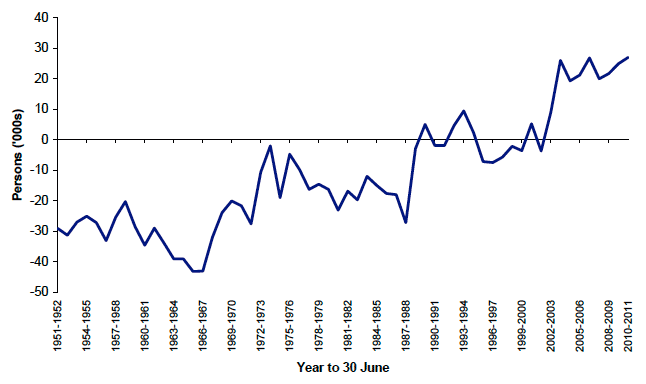
Chapter 5 - Migration
Unlike some countries, the UK does not have a comprehensive system of recording migrants, particularly those leaving the country, nor any legal requirement to notify change of address. So migration is the most difficult component of population change to measure and predict. Migration and the reasons for migrating are also much more susceptible to short-term changes in social and economic circumstances than births and deaths. More detailed information on the methodology for estimating migration is available on our website at: http://www.nrscotland.gov.uk/statistics-and-data/statistics/statistics-by-theme/migration/methodology
Trends in migration since 1951
Historically, Scotland has been a country of net out-migration, with more people leaving to live elsewhere than moving to live in Scotland. However, since the 1960s, net out-migration has greatly reduced and, in some years during the late 1980s and early 1990s, Scotland experienced net migration gains. As Figure 5.1 shows, Scotland has now entered a period of net in-migration. Over the last eight years, there have been net gains of at least 19,000 per year. In 2010-11 the net migration gain was 27,000, the highest since these estimates started in 1951.
Figure 5.1 Estimated net migration, Scotland, 1951-2011

Net migration is the difference between much larger flows of migrants into and out of Scotland. The level of net migration can be significantly affected by relatively small changes in these gross flows from year to year, particularly if one flow rises while the other falls. In the last eight years, migration to Scotland has typically been about 90,000 per year whilst migration from Scotland has been around 70,000.
In the year to 30 June 2011, around 43,700 people came to Scotland from England, Wales and Northern Ireland and around 40,800 people left Scotland for the rest of the UK. The net gain of around 2,900 is lower than the net gains of 4,200 in 2009 and 3,500 in 2010, mainly because fewer people are coming to Scotland from the rest of the UK though also fewer people are leaving.
During the same period, about 42,300 people came to Scotland from overseas and around 16,900 left Scotland to go overseas, giving a net migration gain from overseas of around 25,400. This is the highest net migration gain from overseas in any year, beating the previous high of 21,500 in the year to June 2010. Estimating international migration is particularly difficult as the estimate is based primarily on the International Passenger Survey (IPS). This is a sample survey conducted at main airports and ports across the UK, and the sample size for Scotland is very small (around 220 migrant contacts in 2010-11). Internationally, migrants are defined as people who change their country of usual residence for 12 months or more. So short-term seasonal migrant workers, including many people from the Eastern European states which joined the EU in 2004, will not be counted in the migration estimates, and hence will not be included in these migration estimates.
Origins and destinations of migrants
Figure 5.2 illustrates the trend in flows of people to and from the rest of the UK since 1981. There have been drops in in-migration to Scotland from the rest of the UK for the last three years in a row, down to 43,700 in 2010-11 from the recent peak of 61,900 in 2003-04. The downward trend in out-migration, which began in 2000, is continuing.
Figure 5.2 Movements to/from the rest of the UK, 1981-2011
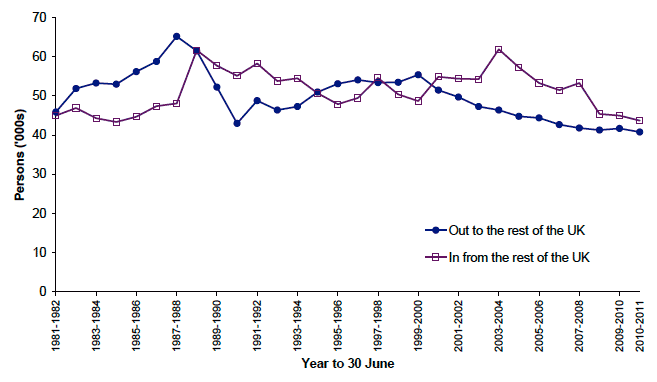
Figure 5.3 shows the trends in flows of people to and from overseas since 1991. In-migration from overseas has been increasing since 2003 but dropped slightly in 2010-11. Out-migration to overseas has dropped three years in a row following a large rise in 2007-08. The figures shown here are from the Long-Term International Migration (LTIM) series produced by the Office of National Statistics (ONS).
Figure 5.3 Movements to/from overseas, 1991-2011
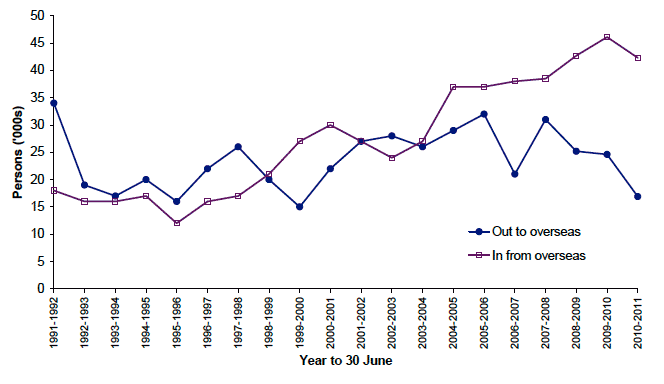
Source: ONS long-Term International Migration.
Table 5.1 summarises the migration flows between Scotland and the rest of UK and Scotland and overseas between mid-2010 and mid-2011. The in-flows of migrants from the rest of UK and overseas are similar. However, the out-flows to overseas are much lower than the outflows to the rest of the UK. As a result, the largest component of the total net migration is net in-migration from overseas.
Table 5.1 Migration between Scotland and Rest of UK/Overseas: 2010-2011
| In | Out | Net | |
|---|---|---|---|
| Rest of UK | 43,700 | 40,800 | 2,900 |
| Overseas | 42,300 | 16,900 | 25,400 |
| Total 1 | 86,000 | 57,700 | 28,300 |
1. Movements between Scotland and the rest of the UK and overseas will not sum to total net migration as they exclude movements to and from the armed forces and rounding adjustments.
Age and sex of migrants
Figure 5.4 illustrates the ages of people moving between Scotland and the rest of the UK between mid-2010 and mid-2011. The peak age for migration into Scotland is 19, at which age there is a marked migration gain. The peak ages for migrating out of Scotland are 23 and 24 and this results in a migration loss at these ages. These large in and out flows result from an influx of students from outside Scotland starting higher education, followed by a move out of Scotland after graduation.
Figure 5.4 Movements between Scotland and the rest of the UK, by age, mid-2010 to mid-2011
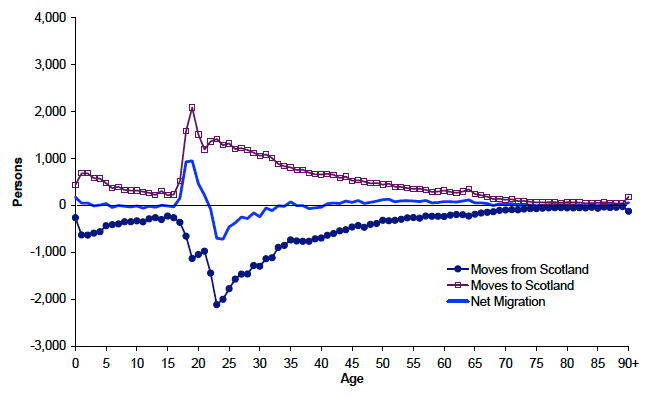
Figure 5.5 shows the age distribution of people moving between Scotland and overseas between mid-2010 and mid-2011. In contrast to moves to Scotland from the rest of the UK, the peak ages for migration into Scotland are 22 and 23. There are also high numbers of migrants from age 19 to 31. This results in a net migration gain through to age 55.
Figure 5.5 Movements between Scotland and overseas, by age, mid-2010 to mid-2011
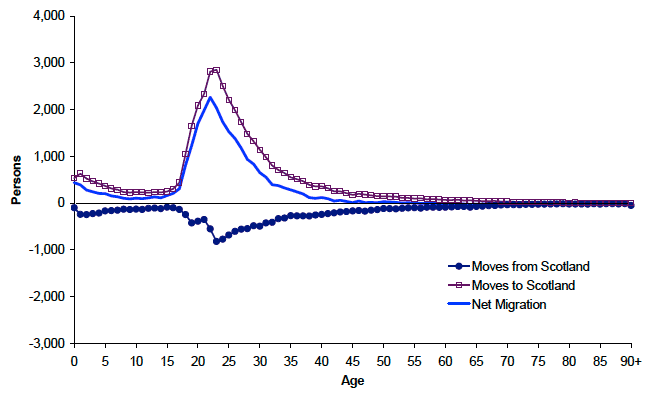
Migrants to and from the UK and overseas alike tend to be much younger than the general population: 48 per cent of in-migrants from the rest of the UK and 71 per cent of those from overseas are aged 16-34, compared with 25 per cent of the resident population. There also tend to be smaller peaks for moves of the very young, under the age of 5, as their parents move home before their children have started school. Later in life, there is no significant 'retirement migration' in either direction. The pattern of migration is very similar for men and women.
Migration and the distribution of people in Scotland
In many parts of Scotland, migration is the most important component of population change. Net migration rates (here, the amount of net migration between 2001 and 2011 as a proportion of the 2001 population) are a useful indicator when comparing migration between areas of different sizes. Information on net rates for Council areas, which includes migration between Council areas, the rest of the UK and overseas, is shown in Figure 5.6.
The patterns of migration over the period 2001 to 2011 indicate that the highest net out-migration rates were in West Dunbartonshire, East Dunbartonshire and Inverclyde. The highest net in-migration rates were in Perth & Kinross, City of Edinburgh and East Lothian.
Figure 5.6 Net migration as percentage of population by Council area, 2001-2011
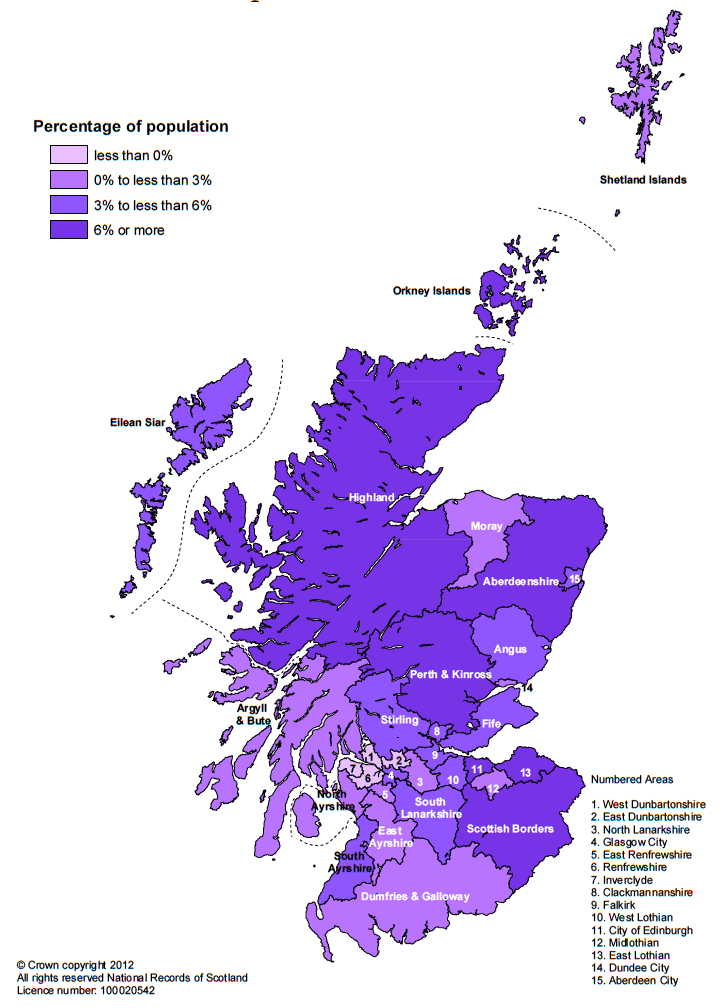
Migration between Scotland and the rest of UK and overseas shows a slightly different pattern. Migration in the period mid-2010 to mid-2011 to and from areas outside Scotland, as a proportion of the resident population, is shown in Figure 5.7. The highest net in-migration rates were in the city council areas of Aberdeen, Edinburgh and Stirling. The highest net out-migration rates were in East Ayrshire and Inverclyde.
Figure 5.7 Net migration with areas outside Scotland as percentage of population by Council area, mid-2010 to mid-2011
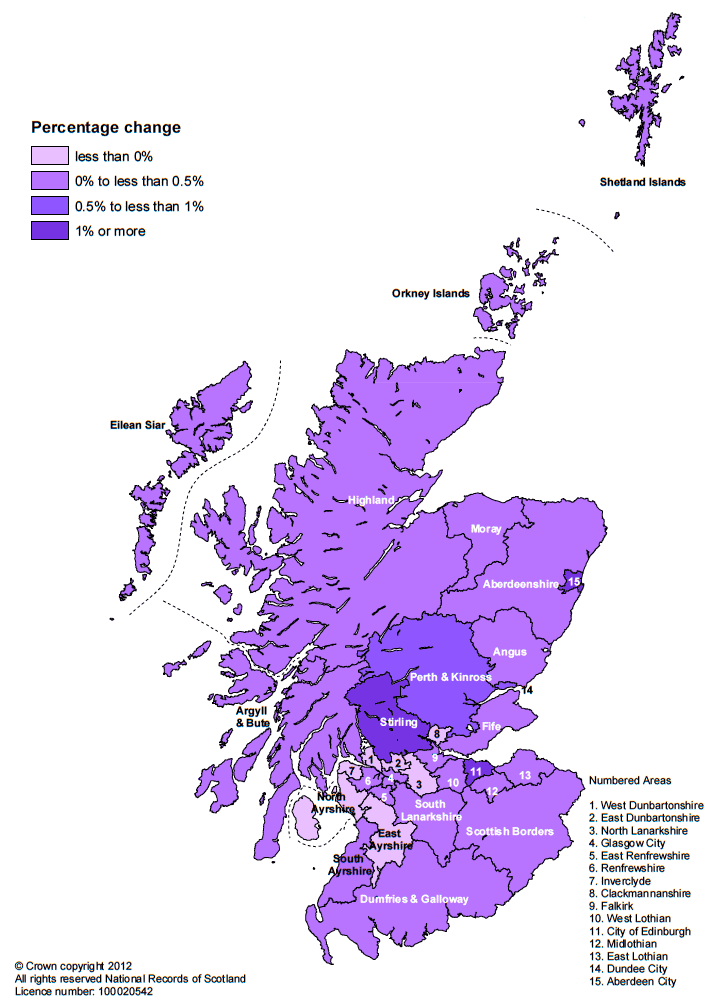
Improvements in migration statistics
Since the early 2000s, and especially since Eastern European Countries joined the EU in May 2004, migration has played a larger part in Scotland's demographic change than in the previous decade. So it has become more important to have high quality statistics on migration and the population, for policy development and for planning and providing public services. NRS was part of an inter-departmental effort, led by the Office for National Statistics (ONS), to improve the estimates of migration and migrant populations in the United Kingdom, both nationally and at a local level. The ONS website has more information on the Migration Statistics Improvement programme including the programme's final report.
Although the programme has now finished, work to improve migration statistics is continuing. In Scotland the key focus will be reconciling the mid-year estimates with the 2011 Census results and rebasing historical estimates. As part of this work we will review our methods for estimating migration.
More information about migration statistics
More detailed information about Scotland's migration can be found at: http://www.nrscotland.gov.uk/statistics-and-data/statistics/statistics-by-theme/migration